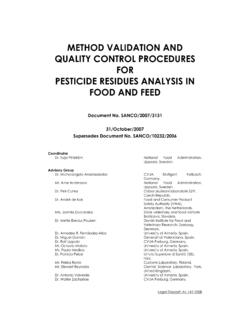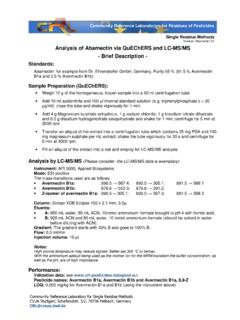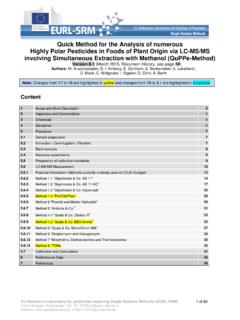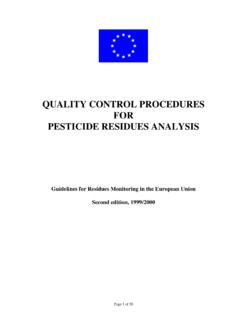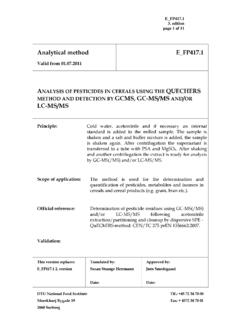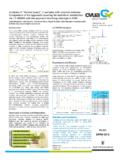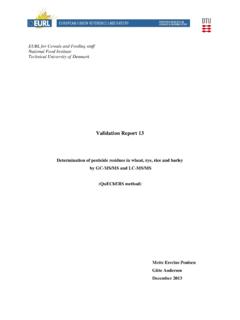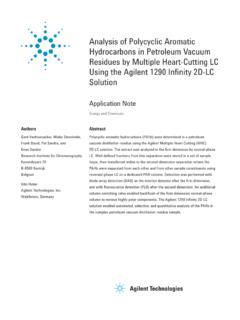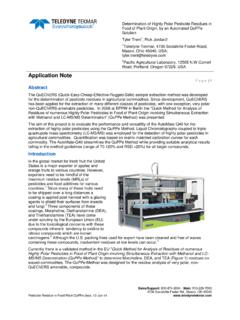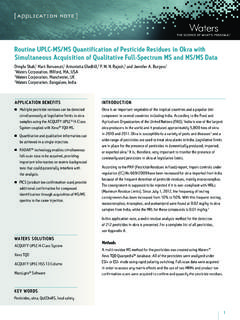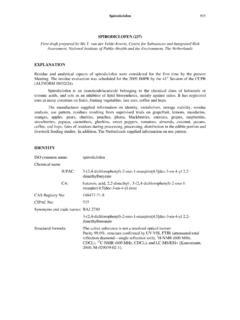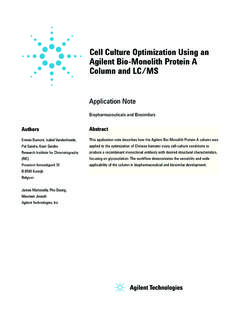Transcription of EURL-FV - Residues of Pesticides
1 EURL-FV . analysis of pesticide Residues in fruit and vegetables with ethyl acetate extraction using gas and liquid chromatography with tandem mass spectrometric detection 1. CONTENTS. 1. Introduction _____ 3. 2. Application area/matrices _____ 3. 3. Principles_____ 3. 4. Limit of Quantification _____ 3. 5. Reagents and chemicals_____ 3. 6. Apparatus_____ 4. 7. Extraction _____ 4. 8. Determination _____ 4. LC -MS/MS: Instrumentation and settings _____4. GC-MS/MS: Instrumentation and settings _____5. 9. Figure1. The analytical flow scheme of the ethyl acetate method _____ 7. 10. Validation design _____ 7. Recovery results _____7. 11. Precision-repeatability _____ 8. 12. Linearity test and calibration curve _____ 8. 13. Stability of standards _____ 9. 14. Robustness _____ 9. 15. References _____11. 16. Contact information _____11. 17. Acknowledgements _____11.
2 18. Appendix 1. Mass transitions LC-MSMS (ES+) _____12. 19. Appendix 2. Mass transitions of GC-MSMS _____19. 20. Appendix 3 . Limit of Quantification (LOQ) and detection technique____24. 21. Appendix 4. The stability of working standards_____32. 2. 1. Introduction The Swedish National Food Administration has since 1989 employed a multi residue method that is based on extraction with ethyl acetate followed by LC and GC determination1. The multi residue method has been revised continuously resulting in an improved and simplified methodology for analysis of Pesticides Residues . For example, the need of clean up has been eliminated entirely and to improve the recovery of basic Pesticides the addition of sodium hydrogen carbonate has been used to all matrices. The use of LC-MS/MS and GC- MS/MS has further enhanced the analytical quality and performance.
3 A previous drawback of the method has been the relatively large sample size (75 g) and the large volume of extraction solvent (200 ml), which made the sample preparation rather cumbersome and limiting to the sample throughput. Recent developments of the method enable the use of a smaller sample size of 10 g following a volume of 20 ml of ethyl acetate. Before extraction in 50 ml Falcon tubes a reduced amount of NaHCO3 and Na2SO4 was added to all matrices. Furthermore, in improving the analytical step, the chromatographic aspects were taken into consideration including the use of columns with small particles ( m UPLC column). resulting in the reduction of analytical time in LC-MS/MS from 30 minutes to 16 minutes. Finally, the previously employed solvent switch from ethyl acetate to methanol has been eliminated saving time and reducing the number of analytical steps.
4 2. Application area/matrices The method is used for analysis of pesticide Residues in fruit and vegetables by means of LC- MS/MS and GC-MS/MS detection and has been validated according to SANCO. 10684/20092 for three selected commodity groups (see Annex 1) 1) high water content. 2). high acid content and high water content and 3) high sugar and low water content. 3. Principles Residues are extracted from food matrix with ethyl acetate. Sodium hydrogen carbonate is added to well homogenised crop sample which is extracted with ethyl acetate. After centrifugation and filtration the extract is injected to GC-MS/MS and LC-MS/MS. No clean up is needed. For more details see Figure 1 Analytical flow scheme. 4. Limit of Quantification The Limit of Quantification (LOQ) of the method is mg/kg for most of the analytes. Appendix 3. 5. Reagents and chemicals Methanol, gradient grade Ethyl acetate, pestiscan grade.
5 Acetone, pestiscan grade Acetic acid 100 %. Ammonium, ca 25 % NH3 (ca M. Sodium sulphate, water free. Sodium hydrogen carbonate, water free. 3. 6. Apparatus Sample processing equipment. for example Cut-O-MAT H10/4 Standard Automatic pipettes suitable for handling volumes of 10 to 20 L, 100 to 1000 L, to 5 mL and 1 to 10 mL. 50 ml centrifuge tubes with screw caps, for example mm PP. 25 mL volumetric cylinder for ethyl acetate. Syringes, 10 mL disposable syringes. Syringes filters, m pore size. Injection vials: ml suitable for LC and GC auto-sampler. Centrifuge for example Hettich Rotanta/AP (Germany). Ultrasonic bath for example Sonorex RK100. 7. Extraction 1) Weigh g sodium hydrogen carbonate (NaHCO3) to 10 sample in a 50 mL. centrifuge tube 2) Add 10 g sodium sulphate (Na2SO4) and 20 ethyl acetate and extract by shaking (30 sec) and ultrasonication (3 min), max 35 C.
6 3) Centrifuge 3 minutes at 3200 g. 4) Filtrate the crude extract through a m PTFE filter 5) Inject to GC-MS/MS and LC-MS/MS. For analysis of dried fruits (water content of ca 20%) addition of water is needed before extraction. Add 750 g cold water (4 C) to 500 g dried fruits and homogenate the sample. Weigh 25 g sample corresponding 10 g dried fruit and add 20 ml ethyl acetate as described above. 8. Determination LC -MS/MS: Instrumentation and settings Any suitable LC -MS/MS conditions may be used. More detailed information of the LC- MS/MS measurement conditions is available in the validation report below. Instrumentation Agilent 6410 triple quad LC-MS system Agilent 1200 HPLC. Proposed settings for mass spectrometry Cycle time 500ms Gas flow: 5 l/min Total MRMs 212 Nebulizer: 45 psi Concurrent MRM 60 Sheath Gas Temp: 2500C. Min/Max Dwell Sheath Gas Flow: 11 l/min Pressure start 600bar Capillary: 3500 V.
7 Pressure max 880bar Nozzle voltage: 500 V. Gas Temp: 3500C. 4. Proposed UPLC conditions for chromatographic separation were following: Column: - Waters HSS T3, 150x , m - Column temperature: 45 C. - Mobile phase A: 10 mM ammonium formiate. pH 4. - Mobile phase B: methanol - Injection volume: 2 L. - Total run time: 16 min. Table 1. Flow rate and elution gradient Time Flow Rate A B. (min) ( l/min) (%) (%). 0 450 95 5. 11 450 5 95. 13 450 5 95. 450 95 5. 16 450 95 5. GC-MS/MS: Instrumentation and settings Any suitable GC-MS/MS conditions may be used. More detailed information of the GC- MS/MS measurement conditions is available in the validation report. Used/proposed instrumentation/GC conditions are presented below. Instrumentation: Varian 1200 Quadrupole MS/MS. Varian CP-3800 Gas Chromatograph Varian 1079 GC injector Varian CP-8400 Autosampler Electron ionisation at 70 eV and an ion source temperature of 320 C were applied.
8 Collision energies are optimised for each pesticide. See settings in Appendix 2. GC Column: FactorFour VF-5ms w/EZ-Guard (30+10m. mm ID. m df), P/N: CP9013. Gas flow: ml/min (constant flow mode). Carrier gas: Helium Gas: Helium, Alphagaz 2 (Air liquid ). Argon, Alphagaz 1 (Air liquid ). 5. Varian 1200 Quadrupole MS/MS detector: Collision gas: Argon Solvent Delay: min Varian CP-3800 GC: Initial Temperature: 90 C. Initial Time: min GC oven ramp: Rate ( C/min) Final temp ( C) Hold Time (min) Total Time (min). 180 280 Post-run temperature: 320 C. Post-run time: 10 min Varian 1079 GC injector: Initial Temperature: 170 C. Initial Time: min Injector oven ramp: Rate ( C/min) Final temp ( C) Hold Time (min) Total Time (min). 280 40. Varian CP-8400 Autosampler Syringe volume: l Injection Volume: l Air Volume: l Solvent plug: l (ethyl acetate).
9 Pre Clean with Solvent1: 3 (acetone). Pre Clean with Solvent2: 3 (ethyl acetate). Pre Clean with sample: 0. Filling Speed: l/s Filling Strokes: 3. Injection Speed: l/s Pre Inject Delay: 3000 ms (hot needle injection). Post Inject Delay: 500 ms Post Clean with Solvent1: 3 (acetone). Post Clean with Solvent2: 3 (ethyl acetate). 6. 9. Figure1. The analytical flow scheme of the ethyl acetate method Extraction 10 g sample + 3 g NaHCO3. 10 g Na2SO4 and 20 ml ethyl acetate Falcon tube in ultrasonic bath 3 minutes . Centrifugation in 3 min, (3200 g).. Filtration Filtrate the crude extract m PTFE filter . Inject to GC-MS/MS and UPLC-MS/MS. Sample conc. 10. Validation design The method is validated for at least one commodity from each commodity group as far the commodities are applicable to samples analysed in the laboratory. The analysis of other matrices within the same commodity category is directly applicable.
10 Please refer to the EU-RL Data Pool for single validation results. Registration and login is required. Recovery results The method is validated for all analytes within the scope of the method (Appendix 1). The validation is performed with five recovery values for two concentration levels and mg/kg in three different commodities, orange, raisins and leek. The mean recovery and the within-laboratory reproducibility (RSD) are determined for each matrix /level/commodity combination. Quantification has been done using matrix matched standards. In the majority of cases the quantitative results (70-120 %) with RSD <20% for most analytes/matrix combinations were obtained. Mean recovery for all included analytes at mg/kg (n=5 per analyte) : Orange 92 %. Raisins 93 %. Leek 93 %. Mean recovery for all analytes in all matrices at mg/kg was found to be 93 %, n=15 per analyte.

